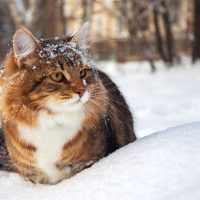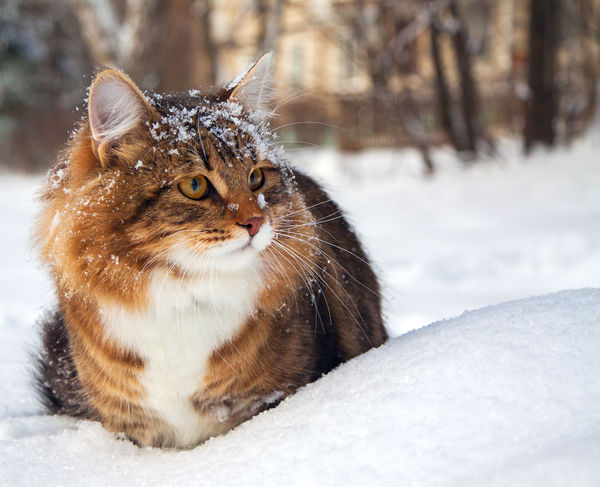
What extra steps can you take to keep kitties safe during the winter? Whether you want to look out for your own feline or a neighborhood cat, we’ve got a few tips specifically for the chilly weather.
- Watch out for antifreeze, salt, and other ice-melting substancesThough these items can work wonders for your car and driveway, they can be dangerous for kitty. For starters, keep them out of reach in your garage or outside. Secondly, always keep an eye out for antifreeze leaks from your car – and if you see any spills, quickly clean them up.Oddly enough, cat litter is actually great for absorbing the antifreeze – many people suggest letting the litter sit on the spill for 30 minutes before sweeping it into a trash can and scrubbing the area with a little laundry soap. Just stay outside to make sure cats don’t try to get into the cat litter. Also, try to find a pet-friendly substance to melt the ice in your driveway. Because cats will walk across salt and other ice melt and then likely lick their own paws, it’s important to avoid potentially toxic supplies. Safe Paw is sold at many hardware stores – e.g. Home Depot and Lowe’s – and is designed to be safer for kitties. You can also try to be diligent about cleaning kitty’s paws when he or she comes inside.
- Build a cold-weather cat shelter
Click here to read our previous article about building a DIY cold-weather cat shelter. In addition to food and water, a warm shelter made out of a rubber storage bin is a simple and great way to help keep feral and stray cats in good health during cold temperatures.
If you leave food and water outside for cats, there are a few things you can do to keep it from freezing (or slow down the process). Firstly, check the bowls frequently to make sure they are not frozen. Or, refill the bowls on a schedule – felines have a sharp internal clock, so they may get used to stopping by at specific times when they know the water is fresh.Secondly, use a heated water bowl or a thick and deep plastic container to hold the food or water. If you have a cold-weather shelter, put the wet food as far away from the doorway as possible. And don’t put the water in the shelter at all – if it spills, then the whole shelter will just be a frozen mess!
A car engine can actually be a pretty warm place for cats to nap, so you want to make sure no felines are sleeping in there before you start the car. If your car is parked somewhere that a cat could access, try honking the horn or banging on the hood before starting the engine – the noise will likely startle the cat and get him or her out of the engine.
If your cat is both an indoor and outdoor cat, consider keeping kitty inside when the weather is really bad outside – especially when temperatures drop to very low numbers. Felines could get caught in snowstorms or catch frostbite from prolonged exposure to very cold temperatures, so it’s something to consider when winter approaches.Frostbite is most likely to happen on the nose, feet, tail, and ears. It makes the affected parts pale or a bit blue in color, and those frostbitten spots feel cooler to the touch than the rest of the cat’s body. They might also look red and swollen once the cat warms up. Try using warm (not hot) water on a cloth to warm the area, and take kitty to the vet as soon as you can to make sure everything’s okay.
These are just a few tips to keep in mind during the winter, to make sure that kitties are as safe and warm as possible!

